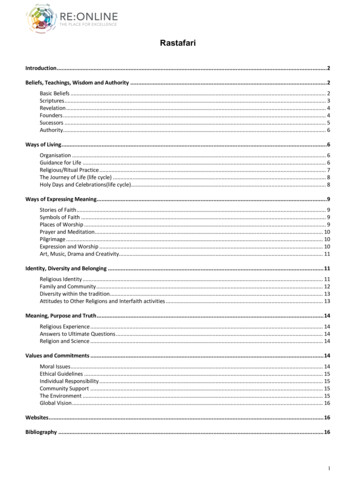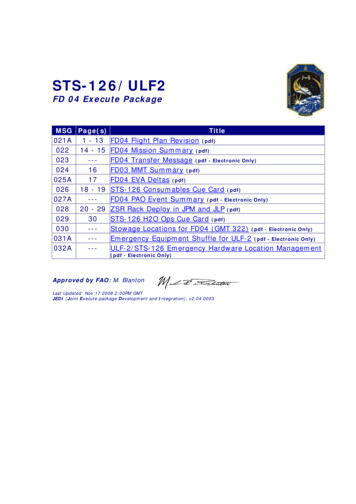
Transcription
RastafariIntroduction. 2Beliefs, Teachings, Wisdom and Authority . 2Basic Beliefs . 2Scriptures . 3Revelation . 4Founders . 4Sucessors . 5Authority . 6Ways of Living . 6Organisation . 6Guidance for Life . 6Religious/Ritual Practice . 7The Journey of Life (life cycle) . 8Holy Days and Celebrations(life cycle). 8Ways of Expressing Meaning . 9Stories of Faith . 9Symbols of Faith . 9Places of Worship . 9Prayer and Meditation. 10Pilgrimage . 10Expression and Worship . 10Art, Music, Drama and Creativity. 11Identity, Diversity and Belonging . 11Religious Identity . 11Family and Community . 12Diversity within the tradition . 13Attitudes to Other Religions and Interfaith activities . 13Meaning, Purpose and Truth . 14Religious Experience . 14Answers to Ultimate Questions . 14Religion and Science . 14Values and Commitments . 14Moral Issues . 14Ethical Guidelines . 15Individual Responsibility . 15Community Support . 15The Environment . 15Global Vision . 16Websites . 16Bibliography . 161
IntroductionWe are indebted to Professor Eileen Barker, Founder and Director of INFORM (the Information Network on ReligiousMovements) and her team of researchers, for providing this new material in response to requests from RE teachers and pupils.INFORM can be contacted via www.inform.acThe resources contained in the list of subjects to the right are a basic introduction to the facts and beliefs of Rastafari.Beliefs, Teachings, Wisdom and AuthorityInterpreting teachings, sources, authorities and ways of life in order to understand religions and beliefs;Understanding and responding critically to beliefs and attitudes.Basic BeliefsRastafari emerged in the 1930s in Jamaica. A central belief is that the Ethiopian King, Haile Selassie I (1892-1975), is the livingGod. Tafari Makonen was the birth name of Haile Selassie I, which was changed upon his coronation on 2 November 1930, and‘Ras’ was his title before coronation, meaning ‘duke’ or ‘prince’. The name ‘Haile Selassie’ means ‘power of the Trinity’. Themovement took his original first name and title as its own. Haile Selassie I identified himself as the 225th King of biblicalEthiopia. However, it is unclear whether he ever supported the Rastafari belief that he was also divine. For Rastas, HaileSelassie I is the black messiah, who redeems black people who have been exiled from Africa through slavery. Rastafari beliefsreject the subordinate status of black people under colonialism. It was a radical reformulation of Jamaican social conditions inthe early 20th century. These conditions were still structured according to the colonial order where white, European people heldhigher status, while black, African-descended people were enslaved. In 1807 the slave trade was abolished throughout theBritish Empire, and then in 1833 slavery as an institution was abolished, due in part to a revolt by slaves in Jamaica.Jamaica had a history of resistance to slavery, including the Maroons and revolts which often took a religious form [1]. In theearly 20th century Jamaica and the rest of the British Empire was still a two-tier society. The claim that God was black, and thatJesus was also black, is an inversion of the racial order supported by Protestantism, which was the dominant form ofChristianity associated with the Empire. Rastafari was just one of a number of ‘revival’ religions inspired by African religioustraditions, mixed with elements of Christianity and Caribbean innovations. These new religions appealed to black peopledirectly, providing hope and pride in their status as African-descended Caribbeans, rather than offering salvation throughassimilation to white, European Christianity.Rastas refer to God as ‘Jah’, which is a shortened form of the biblical ‘Yahweh’ or ‘Jehovah’ as in Psalm 68:4 of the King JamesVersion of the Bible. Jah is spirit that has been manifested in the historical persons of Moses, Jesus, and Haile Selassie I.However, Jah is also present in all people. This concept is invoked through the phrase ‘I and I’. In earlier Rastafari thought, thiswas limited to black people. As a rejection of the subjugated status of black people as the descendants of slaves, Rastafariviewed black people as the reincarnation of the biblical Israelites, meaning that they are God’s chosen people. Black peoplewere taken as slaves and were then living in exile in Babylon, a land of oppression, adapting the biblical narrative of the Jews’exile in Babylon. ‘Babylon’ is the name Rastas give to the white colonial system. It stands for evil. Rastas will be delivered fromBabylon through a return to Zion, which for Rastafari is Ethiopia or Africa more generally. Ethiopia is heaven, also known asZion, this is the Promised Land for the chosen people, where they will finally be free. Jamaica is Hell.The repatriation of all black people to Africa was meant to occur whenever Haile Selassie decided. Repatriation is the Rastafarisymbol of the return to freedom. It is a fulfilment of biblical history, in which the true children of Israel held captive in Babylon areset free in Zion. In the Millennium, the time after the Second Coming when God’s Kingdom is on Earth, the saved will sail to thePromised Land, which the Rastafari identified variously as Africa, Ethiopia, and Mount Zion. Repatriation would be symbolisedwith seven miles of ships leaving from darkness and hell fire. In the emerging movement this took a particular racial form thatblack people will be saved because they are special to God. In later formulations, Zion and Babylon are understood symbolicallyas states of being, which can be cultivated by people regardless of race. Rastafari beliefs can be seen as a religious formulation RE:Online. Rastafari2
of social and political resistance to slavery, colonialism, and imperialism. Scholars have discussed whether it is best understoodas a religion or an expression of black cultural or political identity, but some have concluded that it is impossible to separate outthese strands.Ethiopianism is an important influence on Rastafari beliefs, especially as formulated by Marcus Garvey (1887-1940). Garveywas a proponent of Black Nationalism and founded the United Negro Improvement Association and African CommunitiesLeague. In his Pan-Africanism, Ethiopia-Africa is the Promised Land to which the African diaspora created through slaveryshould return. Garveyism was religious as well as political, asserting that God is black. Ethiopia was viewed as a greatcivilisation that existed prior to the white colonial empires. Garvey supported this belief with biblical references to Ethiopia andEgypt, which he used to construct a historical mythology of the superiority of black people. Garveyism formed the doctrinal baseof the Rastafari movement, which also believed white people, through their actions as colonial oppressors, were inferior to blackpeople, who were God’s chosen people. However, the beliefs from the 1930s to the 1970s differed from post-1970s beliefs,when emphasis on black superiority and racial segregation gradually decreased. Rastafaris in the 21st century continue to seethe post-colonial social structures as evil, but individual white people are seen and judged separately, based on their behaviour.God is an immanent deity for Rastas, meaning that God is inherent in all people and that everyone is connected. The divine isfound in the individual. This belief has far-reaching consequences. There is no single authority on doctrine for the Rastafari; it isup to individual interpretation how God or Jah is manifested for them. This means beliefs are fluid, as is membership, which isoften a gradual process of realisation. There is no conversion ritual such as baptism or any creed to recite to make oneselfRastafari. There is a general dislike of ‘isms’, which is why most scholars do not call it ‘Rastafarianism’. Rastas use the word‘livity’ to denote following ital norms such as dietary and clothing regulations (explained below) but more broadly to refer to theRastafari way of life, severing oneself from the ways of the West and embracing the spiritual, social, political and cultural waysof the black God. There is no agreed system of beliefs, as Rastafari beliefs are open to debate and interpretation. However,there is a widely shared theology: Haile Selassie I is the living God, Ethiopia is the home of black people, redemption throughrepatriation is close, and the ways of white people are evil. This could even be reduced to two essential truths: Haile Selassie Iis the living God and salvation for black people will come through repatriation to Africa, although for many in a symbolic ratherthan a physical sense. There are also a number of complementary and sometimes paradoxical ‘truths’ in Rastafari that are usedas ways of explaining the past, present, and future circumstances of black people.1. Maroons were Africans who had escaped from slavery and established free communities in the mountainous interior ofJamaica.ScripturesThe Bible in the form of the King James Bible is a holy book for Rastafari, but not all of the contents are acceptable. Theybelieve that the Bible as it was originally written gave the early history of the black race, their identity and destiny as the chosenpeople of Jah. They believe it was originally written in Amharic (the language of Ethiopia) and corrupted by later translations tosupport the philosophy of the European slave masters. Part of Rastafari practice is therefore decoding the Bible, learning how todecrypt it as a book of symbols and debate it in their meetings. They focus in particular on the Old Testament. Psalm 87:3-4 isread as proof that the messiah will be born in Ethiopia. Daniel 2:31-42 is read as meaning that black people are destined to rulethe world. Psalm 68 was central to the Garvey movement and is also one of the most frequently quoted in the Rastafarimovement. The Book of Revelation is a central text, in particular the prophecy about the Emperor, whose titles, ‘Lion of theTribe of Judah’ (Rev 5:2-5) and ‘King of Kings’ (Rev 19:16), mirror Haile Selassie I’s titles. References to Jesus in the Bible areread as references to Haile Selassie, the black messiah, whose true nature was hidden as white by the slave masters. Despitetheir view of the Bible as corrupted by white people, Rastafaris use the Bible because Haile Selassie, an Orthodox EthiopianChristian, advocated it. However, they accept only their own interpretations by, for example, reading references to the devil asreferring to the god of white Christianity.The Bible is looked to as a source for Rastafari ways of living. There are biblical justifications for ganja use in Genesis 1:12,Genesis 1:29, Genesis 3:18, Exodus 10:12, Proverbs 15:17, Psalm 104:14, Psalm 18:18, Revelation 22:2, and many others.Dreadlocks are justified with Old Testament proscriptions against hair cutting such as “They shall not make baldness ”Leviticus 21:5, and Numbers 6:5, and 1 Corinthians 11:4-6 for women covering their hair. Rastas recite Psalm 133: “Behold,how good and pleasant it is for brethren to dwell together in unity” at the beginning of meetings. Reading scripture is a regularpart of weekly and monthly meetings. In ‘reasonings’ they strive to find hidden ‘true’ meanings in the Bible. One of the strictest RE:Online. Rastafari3
‘Mansions’ of Rastafari, the Bobo Shanti, read a section of the Bible nonstop for three hours, starting with Laws, then Prophets,and ending with the Gospels and Epistles, rarely commenting on what they are reading.The work of Marcus Garvey and his organisation, the United Negro Improvement Association (UNIA), form a source of scripturalinspiration to Rastafari. Revered by Rastafaris as an inspirer, Garvey is second only to Haile Selassie. Garvey advocated aback-to-Africa movement. His spiritual mission was fighting against the social and economic oppression of black people inJamaica and worldwide. A movement formed around him, which he organised into the UNIA in 1914. His work promulgatesPan-Africanism, a worldwide confraternity of black people, with Africa as the united self-sufficient black nation. All black peoplecould return there. He supported establishing black educational institutions for teaching about black cultures and worked to upliftthe black race, proclaiming “Africa for the African at home and abroad”. However, he never visited Africa himself; it was asymbol of a homeland that was never realised. He was never accepted in his native Jamaica, only achieving success in theUnited States. Garvey did not approve of Rastafari, which he saw as a form of religious fanaticism.Other significant scriptures for the Rastafari include the Holy Piby, written by Robert Athlyi Rogers, an Anguillan, in the 1920sand distributed by the early Rastafari preacher, Leonard Howell. Rogers wrote it to support his own Afrocentric religion, the AfroAthlican Constructive Church, in which Ethiopians (meaning black Africans) were God’s chosen people and Marcus Garvey wasan apostle. Rogers’ church did not find much support, but the Holy Piby became an early scriptural resource for Rastafari. TheRoyal Parchment Scroll of Black Supremacy by Fitz Ballintine Pettersberg, an African American preacher, was also written inthe 1920s and provided inspiration for the early Rastafaris. It refers to King Alpha and Queen Omega and the ‘resurrection’ ofEthiopia. The Promised Key was written in 1935 by Leonard Howell, echoing much of the sentiment and some verbatim text ofThe Royal Parchment Scroll of Black Supremacy, although with King Alpha being identified as Haile Selassie. My Life andEthiopia’s Progress is the two-volume autobiography of Haile Selassie written over his life and used by Rastafari for inspirationfrom the life of the man that they believe to be the messiah, the incarnation of Jah. The 14th century Kebra Nagast gives anaccount of the meeting of the Queen of Sheba and King Solomon and relates how the Ark of the Covenant came to Ethiopia. Itis used by Rastafari who trace Haile Selassie’s lineage to the Queen of Sheba and King Solomon, making him the descendentof the biblical King David, and his descendants the true Israelites of the Bible to whom God promises salvation.RevelationThe central revelation for Rastafaris is a prophecy by Marcus Garvey, in conjunction with the ascension of Haile Selassie to thethrone. Garvey preached in 1916 (although this is often dated as 1920): “Look to Africa where a black king shall be crowned, heshall be your Redeemer”. This inspired a number of Pan-African and Afro-Caribbean religious movements to expect a blackmessiah. It was not a reference to Haile Selassie specifically, as Garvey did not suggest that he was the messiah. However,with the crowning of Haile Selassie I as Negus Negusta (Amharic for ‘King of Kings’) of Ethiopia in 1930, taking the biblicallyinspired titles of ‘King of Kings’, ‘Elect of God’, and ‘Lion of the Tribe of Judah’ and placing himself in legendary line of KingSolomon, this was seen by some as a revelation from God and a fulfilment of Marcus Garvey’s earlier prophecy. Those hopingfor religious renewal of the African diaspora created by the slave trade saw the coronation as a fulfilment of biblical prophecyand Haile Selassie as the messiah of African redemption. A reading of the prophecy of the Emperor in the Book of Revelationwas taken as confirming Haile Selassie was the messiah due to the titles he adopted. Daniel 7:9 was also read as confirmationthat the messiah was a black man and the king of Ethiopia because of the longevity of Ethiopian kingship. Haile Selassie wasseen as the climax of the revelation of God, whose first manifestation was Moses, the second was Elijah, the third was JesusChrist, then Haile Selassie was the final incarnation, and he would never die.FoundersA number of preachers emerged in the 1930s in Jamaica with similar messages about black self-determination and HaileSelassie as the black messiah. Among those recorded by historians were Leonard P. Howell (1898-1981), Joseph Hibbert(1894-1986), Archibald Dunkley (dates unknown), and Robert Hinds (dates unknown). They may have been Garveyites,although the specific details about their early lives are sparse. The best known is Leonard Howell, who served in the AshantiWar of 1896 and learned several African languages. He visited the United States and there experienced severe racialdiscrimination. Leonard Howell was a leading figure in the early Rastafari movement through his ministry in the West Kingstonslums. Joseph Hibbert lived in Costa Rica from the age of 17; he was a member of the Ancient Order of Ethiopia, a MasonicLodge, before returning to Jamaica in 1931. Hibbert started preaching in St Andrews and then moved to Kingston. Robert Hindswas a follower of the revivalist preacher Alexander Bedward until the latter was confined to an asylum; he then founded his ownKing of Kings Mission, which had the most members of the early known Rastafari groups. Archibald Dunkley was a sailor in the RE:Online. Rastafari4
United Fruit Company, who began a mission in Port Antonio then moved to Kingston. All four were ministers and founders ofseparate groups that claimed to receive the revelation that the newly crowned Emperor of Ethiopia was the messiah of blackpeople.The Rastafari movement began in the slums of Kingston, the capital city of Jamaica, and from there spread to the rest of theisland. The early preachers worked separately and recruited Garveyites, with a core of the emerging movement formed by1934. They offered hope at a time of social and economic depression and hurricane destruction, when the future of the poorseemed bleak. The coronation of a black Emperor identified by preachers as the messiah offered a vision of future renewal forblack people who continued to be oppressed under British colonial rule. Leonard Howell preached six principles: hatred for thewhite race; the complete superiority of blacks; revenge on whites for evil; the negation, persecution, and humiliation of thegovernment and legal authorities in Jamaica; preparation for black people to return to Africa; and Haile Selassie as the supremebeing and only ruler of black people. This teaching presented a direct challenge to the government of Jamaica. Howell wasarrested along with other Rastafari leaders and followers for sedition in 1934 by the British colonial authorities, and Howell wasimprisoned. His teachings were continued by his lieutenants in secret.In 1940, Howell founded a commune called the Pinnacle in the hills of St. Catherine, outside Kingston. The members werefollowing the example of the 19th century Maroons, who had rebelled against slavery on the plantations of Jamaica and takenup arms against the colonial authorities, living in the hills in a self-sufficient community, which served as a beacon to otherslaves in assisting their escape. Between 500 to 1600 followers lived at various times in Howell’s self-sufficient community atPinnacle. Howell proclaimed himself the chief, styled after African tribal organisation. He allegedly had 13 wives. The communesubsisted on its own produce but also planted cash crops to sell in Kingston, including ganja (marijuana) which went on toassume religious significance for Rastafari. In January 1941, the police raided the commune, having been tipped off byneighbours that the Rastafari had demanded taxes from them in the name of Haile Selassie. Howell was arrested andimprisoned again. The Pinnacle community dispersed in his absence.The second phase of Pinnacle began in 1953, and it was during this period that some Rastas started growing the distinctivedreadlocks. The commune was raided and the members were arrested again in 1954. Pinnacle was destroyed on 22 May 1954.By this time, Howell was claiming that he was divine; following the destruction of Pinnacle his followers deserted him, and hewas committed to a Kingston mental hospital in 1960. In 1975, he was living with followers in Bushy Park, a few miles from theoriginal Pinnacle site. Howell has been charged with acting as an autocrat at Pinnacle by historians of Rastafari, because hemeted out punishments and was in charge of everything. He was the first to use the honorific ‘Gong’, an abbreviation of thename ‘Gangunguru Maragh’ which has an East Asian origin with Gangunguru translated as ‘teacher of famed wisdom’ andMaragh as ‘king’. The other early preachers achieved less lasting renown (or infamy), but each was a charismatic figure in theearly movement. Hinds and Dunkley were seen as prophets. Joseph Hibbert was thought to have powers of clairvoyance, tosee the truth of the past and what would happen in the future. Hibbert based his organisation on ‘occultism’, reading secretshidden in the Books of Maccabees (these texts are not in the Hebrew Bible and are either relegated to a section called‘Apocrypha’ or omitted from Protestant Bibles, but included in Roman Catholic versions). While he was known for having occultpowers, he did not like teaching his secrets to his followers who subsequently left him.SucessorsThe Rastafari do not have a formalised structure with anointed leaders. Elders are generally given respect; this is consideredsomething they earn through living the Rastafari way for many years. As such, there are few figures who are held above othersas ‘successors’ of the original preachers. Prince Emmanuel (Charles) Edwards (1915-1994) founded the group or ‘mansion’ ofBobo Shanti in 1958 in Bull Bay, Jamaica (see ‘Diversity’ below). It was then that he called the first Nyabinghi in 1958. Theseare communal celebrations of Rastas (see ‘Religious/Ritual Practice’ below). Edwards lived in the Back-O-Wall commune inKingston until 1966 when his group was driven out by police. He claimed that he ‘appeared’ in St Elizabeth in 1915, that he hadno father or mother, and that he was the reincarnation of the biblical Melchizedek. He was a key figure in the confrontations withthe Jamaican government in the 1950s and 1960s. He led an attempted repatriation in 1959 that failed.The reggae musician Bob Marley is a prophet and poet for Rastas and for Jamaicans more generally. As a teenager, Marleywas apprenticed to a Rastaman and adopted the beliefs and ways of living himself. His music uses the rhythms of traditionalRastafari drumming. Many of his famous songs include Rastafari teachings. As a member of the Twelve Tribes (see ‘Diversity’below), Marley’s understanding of the livity was fairly unusual; however he became widely popular among Rastas. Marley wasto the 1970s English and American Rastas what Marcus Garvey was to the 1930s Jamaican Rastas: a prophet and an RE:Online. Rastafari5
inspiration. He was instrumental in the spread of Rastafari to the UK and the USA in the 1970s through disseminating Rastafariideas and themes throughout the world using his music. While not every Rastafari sees him as a prophet, he has been veryinfluential for the movement. He became a symbol of the archetypal Rasta after his death in 1980. He was posthumously giventhe Order of Merit, the third highest honour in Jamaica, and buried with a state funeral.AuthorityHaile Selassie was deposed in 1974 by Marxist revolutionaries and died the following year on 27 August 1975 in suspiciouscircumstances. His ignominious fall from power and death undermined the idea that he was a living God, although thecircumstances left enough doubt to allow other accounts of his fate to spread. There were three main responses to the death ofHaile Selassie: that he is still alive and reports of his death were a lie spread by the agents of Babylon; that his spirit assumed adifferent physical form and therefore continues to live; that it was irrelevant because Haile Selassie the man was only apersonification of Jah. Haile Selassie remains a spiritual pr
The Bible is looked to as a source for Rastafari ways of living. There are biblical justifications for ganja use in Genesis 1 :12, Genesis 1:29, Genesis 3:18, Exodus 10:12, Proverbs 15:17, Psa










